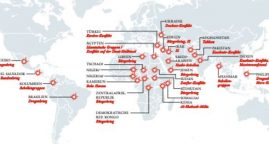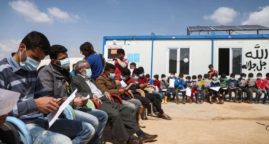How America Receives Refugees
Article published on The New Yorker website on 02/20/2017 (By Richard Brody)
“We Were So Beloved” is Manfred Kirchheimer’s personal documentary about the German Jews who made it to the United States—and those who didn’t.
The dead are haunting “We Were So Beloved,” Manfred Kirchheimer’s personal documentary, from 1986, about the Washington Heights community of German Jewish people who escaped or survived Nazi Germany. It’s a film about Kirchheimer himself, who arrived in New York in 1936 with his parents, and about the new life that they built as refugees. It’s also a film about those who didn’t make it to the United States and were killed by the Nazis. Interviewed in his apartment, Kirchheimer’s father, Bert, states that forty-six members of his family were killed by the Nazi regime. A family friend, Mrs. Krakow, says that she lost more than twenty family members in the Holocaust. And virtually all the interviewees attest to the fact that many more European Jews could have been saved were it not for the United States’ stringent immigration quotas.
Immigration policies established in 1924, which one of Kirchheimer’s childhood friends, Louis Kampf, calls discriminatory, prevented many German and Austrian Jews—who were, for a time, being encouraged by the Nazis to emigrate—from escaping Hitler’s reach when it was still possible. Sary Lieber recalls that she and her husband went to the American consulate and received their “waiting number”—their place in line based on country of origin. Max Frankel, another of Kirchheimer’s childhood friends (who went on to become the Times’s executive editor), tells of his family’s being denied immigration papers because their American sponsor wasn’t deemed wealthy enough. There were, Kirchheimer says, two hundred and fifty thousand Jews still living in Germany and Austria when the war broke out—but because of American quotas it would have taken twenty-six years to admit them all to the U.S. Ilse Marcus and her family were among the nine hundred Jewish refugees on the ocean liner St. Louis, which, in 1939, was turned away from Cuba and then the U.S. The Marcuses ended up in Auschwitz; Ilse was the family’s sole survivor.
Yet many of the film’s participants consider the canker of authoritarianism to be a part of their own heritage as Germans. Frankel admits that, as a German child, he looked longingly at a parade of Brown Shirts from which he was, of course, excluded. Some cite deference to authority as the reason that many Jews hesitated to leave Germany. Some of the survivors in the Kirchheimer circle remain, at the time of the film, vehemently unforgiving of Germans. Others think that many Germans acted against their will under government pressure, and many interviewees tell of Germans who courageously defied Nazi law to help them. Bert admits that he himself would never have been able to hide a fleeing Jew, because he considered himself a coward; Frankel recognizes that a totalitarian regime puts each citizen to the test—“Are you willing to put your life on the line for decency?”—and says that he’d “hate to be tested.” The filmmaker himself wonders what, under such circumstances, he might have done, and adds, “Do I want to know?” The film screens Feb. 9 and Feb. 11 in MOMA’s retrospective of Kirchheimer’s films. ♦
Related Articles
A record number of internally displaced
05/11/2007. Conflict, violence and disasters internally displaced 27.8 million people in 2015, subjecting a record number of men, women and children to the trauma and upheaval of being forcibly displaced within their own country.
To put a stop to the killing, these two men spend their entire day talking
04/12/2017. Whenever a conflict appears unsolvable and official diplomacy fails, David Gorman and his colleagues get on a plane.
The Impact of COVID-19 on Humanitarian Crises
03/19/2020. The increasing spread of COVID-19 has dominated global attention. Governments and media are focusing attention on the domestic impacts of the virus and the medical and political responses.





